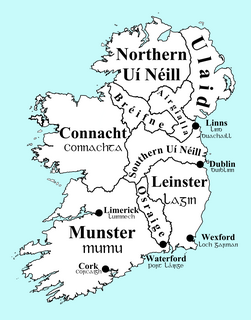Cú Chuarán mac Dúngaile (died 708) was a Dál nAraidi king of Ulaid, an over-kingdom in medieval Ireland. He was the son of Dúngal Eilni mac Scandail (died 681) and brother of Ailill mac Dúngaile Eilni (died 690), previous kings of Dál nAraidi [1]

Dál nAraidi or Dál Araide was a Cruthin kingdom, or possibly a confederation of Cruthin tribes, in north-eastern Ireland during the Middle Ages. It was part of the over-kingdom of Ulaid, and its kings often contended with the Dál Fiatach for the over-kingship of the province. At its greatest extent, the borders of Dál nAraidi roughly match those of County Antrim, and they seem to occupy the same area as the earlier Robogdii of Ptolemy's Geography, a region shared with Dál Riata. Their capital was Ráth Mór outside Antrim, and their eponymous ancestor is claimed as being Fiachu Araide.

Ulaid or Ulaidh ) was a Gaelic over-kingdom in north-eastern Ireland during the Middle Ages, made up of a confederation of dynastic groups. Alternative names include Ulidia, which is the Latin form of Ulaid, as well as in Cóiced, which in Irish means "the Fifth". The king of Ulaid was called the rí Ulad or rí in Chóicid.

Ireland is an island in the North Atlantic. It is separated from Great Britain to its east by the North Channel, the Irish Sea, and St George's Channel. Ireland is the second-largest island of the British Isles, the third-largest in Europe, and the twentieth-largest on Earth.
Contents
In the 6th and 7th centuries the Dál nAraidi were part of a confederation of Cruthin tribes in Ulaid and were the dominant members. [2] Cú Chuarán belonged to a branch of this family settled in Eilne, a plain between the Bann and Bush rivers in modern-day County Antrim, Northern Ireland. This plain had been conquered by the Dál nAraidi by the middle of the seventh century. [3]
The Cruthin were a people of early medieval Ireland. Their heartland was in Ulster and included parts of the present-day counties of Antrim, Down and Londonderry. They are also said to have lived in parts of Leinster and Connacht. Their name is the Irish equivalent of Priteni, an ancient name for the Celtic Britons, and was sometimes used to refer to the Picts. However, there is a debate among scholars as to the relationship of the Cruthin with the Britons and Picts.
Eilne, also spelt as Eilni, alias Mag nEilne, was a medieval Irish Cruthin petty-kingdom in the over-kingdom of Ulaid. It lay between the River Bann and River Bush, and was centered on Magh nEilne, the "plain of Eilne", spanning north-east County Londonderry and north-west County Antrim, in present-day Northern Ireland. Eilne may represent the name of an original population grouping, though even in the Old Irish period who they were was forgotten.

County Antrim is one of six counties that form Northern Ireland. Adjoined to the north-east shore of Lough Neagh, the county covers an area of 3,046 square kilometres (1,176 sq mi) and has a population of about 618,000. County Antrim has a population density of 203 people per square kilometre or 526 people per square mile. It is also one of the thirty-two traditional counties of Ireland, as well as part of the historic province of Ulster.
He would have become king of Dál nAraidi on death of Áed Aired (died 698) ruling from 698 to 708 and king of Ulaid upon abdication of Bécc Bairrche mac Blathmaic in 707 of the Dál Fiatach ruling from 707 to 708. The Annals of Ulster call him king of the Cruthin. [4] The king lists and other annals though also give him the title king of Ulaid.
Bécc Bairrche mac Blathmaic was king of Ulaid from 692 to 707 from the Dál Fiatach clan. He was the son of Blathmac mac Máel Cobha, a previous king. His byname Bairrche refers to the region of the Mourne Mountains in south County Down. Bynames like his can refer to a region or to fosterage and there may be a connection to the Uí Bairrche of Leinster in his byname.

Dál Fiatach was a Gaelic dynastic-grouping and the name of their territory in the north-east of Ireland during the Middle Ages. It was part of the over-kingdom of Ulaid, and they were its main ruling dynasty for most of Ulaid's history. Their territory lay in eastern County Down. Their capital was Dún Lethglaise (Downpatrick) and from the 9th century their main religious site was Bangor Abbey.
Cú Chuarán led an attack on the Irish lands of Dál Riata in northeast County Antrim. [5] The Irish lands of Dál Riata were under attack by the Dál nAraidi since the battle of Magh Rath. He was killed by Scanlán Finn húa Rebáin [6] a member of the Dál nAraidi and the kingship reverted to the Dál Fiatach. [7]
